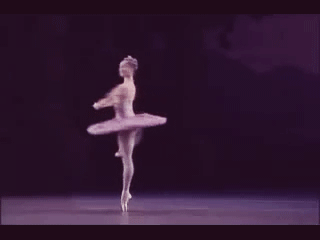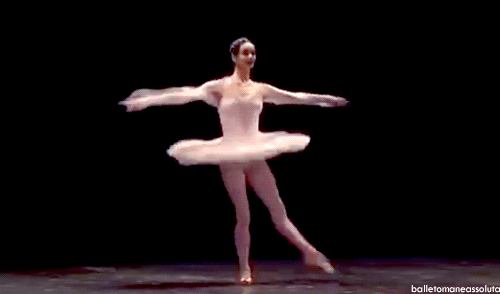Turns require full-body co-ordination and the perfect amount of impetus and speed. They take years to master and whilst some of us take to turning naturally, many of us do not. Despite this, with consistent effort and focus, turning IS something we can all get better at. This post highlights 10 quick tips that can improve your turns. Which ones could you be better at?!
1. Spot – be sure to look with intention and fixate your gaze on where you want to go. Spotting becomes more important once we start going for doubles and triples and especially for fouettés. So even if you generally spot well, if you are aiming for multiple turns, go back to the basics and practice spotting, ensuring your head doesn’t tilt to one side on your way round.
2. Engaged Arms – if you fail to engage your arms they are a dead weight which can pull you off balance. Hold your arms in a clear position and get into that position quickly, the longer you leave the arms lingering, the more likely you are to lose your balance. Generally, it is good advice to keep the arms relatively close to the body and rib cage height or above. If the arms are too high you will end up arching back and if the arms are too low, your shoulders will slump forward. Practice transitioning through the arm movements while stationery to find the right height for you.
3. Use the third eye – remember lifting the chin and looking out of your ‘third eye; helps to improve your posture and alignment. It lengthens the spine and keeps you upright. When turning think more of going up and less about going around – this keeps you over your centre of gravity and makes you less likely to fall out of your turn.
4. Less impetus – Because many of us are truly terrified of turns, we panic and we tend to use more power than we need. We throw ourselves into turns rather than creating a feeling of being lifted and centred. Often with turns, less is more. Mentally strive for a controlled turn, which ends on a demi pointe, and finishes up rather than down. This means the turn should gradually slow to a halt, rather than collapse into an end position. With this focus on controlled turning, we reduce the intensity and often turn better. Think of it this way - greater force in the wrong direction requires more adjustment to find our balance. So, in the early stages, keep it steady
5. Two turned out legs - When it comes to multiple turns, we need to create a counter balance, meaning both our legs should remain turned out for the duration of the turn. If your working leg turns in (on an en dehor pirouette) you will end up turning into the leg and getting stuck. To complete a full turn, think of the working leg as fully turned out and leading the way. Then think of the heel of your supporting leg as turned out and forward. You can learn a lot from how you fall out of turns, if you fall back, your releve is likely not strong enough and your supporting foot is collapsing mid turn. Falling forwards is often an indication of too much impetus or disengaged arms. Falling to the sides can indicate weak or imbalanced obliques. Find out which way you fall and then self-correct.
6. Shoulders broad and back – Slumped shoulders can throw you off balance because it not only interferes with the alignment of your head (and therefore spotting) but also with your ability to correctly hold your arms (which involves engaging your back muscles). Thinking of two square shoulders, broad and pulled back, helps to keep us balanced. Most of us have one arm which is stronger than the other and therefore we tend to use unequal force when turning, which ends up pulling us off to one side. Squaring the shoulders and engaging the back helps to counteract this.
7. A strong releve – Strengthening our feet is a key part of being able to turn. We must be able to sustain the releve for long enough to get around. If you find the supporting leg is collapsing mid turn, then it is time to go back to basics. Start with simple rises and releves at the barre and work towards trying to balance in the pirouette position (for a minimum of 4 counts). Try this both at the barre and in the centre. We must be able to hold a position before we can turn in it. Throughout your turn there should also be good contact between your foot and calf and this should be sustained at the same height throughout a turn. Therefore both of your feet are integral to turning, the stronger they are, the easier you will find it!
8. A secure starting position– make your starting position clear, whether it is third, fifth or fourth, ensure your weight is in the middle, and start with a good deep plie. Plies can help us to get our weight into the right place and they also provide the impetus needed to turn. The starting position is very important, because if your weight is in the wrong place you will need to self-correct while turning which is very hard! A good foundation is a good start. Practicing releves from a fourth or fifth position is a good way to prepare for pirouettes. If you are still struggling, practice quarter turns.
9. No micro adjustments – many people slightly pivot the foot before going into a pirouette, this is either because they are exaggerating their turnout and are therefore not balanced in their starting position or because they haven’t learnt to use the right muscles for turning. From a plie, go straight up into turning without adjusting the feet. Micro adjustments create a feeling of being disjointed and unbalanced, because we are creating more steps than there need to be. This in turn reduces our ability to turn because we exert some of our power in the micro adjustments rather than in the turn. Think of going up into a turning position in one swift motion.
10. Smile - finally and perhaps MOST importantly, experiment with smiling when you turn. It impacts ALL of the above steps. When I tell people to smile in their turns, the tension flows out of their faces and bodies, in turn enabling them to lift their chins, pull back their shoulders and use less force. Mentally relax into turns and create a sense of fluidity – this will totally transform your experience. In the worst case scenario we fall out of a turn entirely – and then we can try again tomorrow!
Let us know if these tips have helped you or if you have any other suggestions in the comments 😊
………………………………………………………………………………………………..
Join a Turns Masterclass with LBC!
If you enjoyed this article and want a more detailed deep-dive into the biomechanics of turning, then you will really enjoy our special Turns Masterclass! We host these workshops once or twice a year - it’s a fantastic way to rewire your relationship with turns. Whether you simply want to understand the different types of turns, how to start, sustain and land turns, OR if you want to better understand YOUR anatomy, what’s holding you back in your turns or receive corrections and enjoy some practice time! Come and join us by clicking the link below!
If you aren’t London based, you can still join us online! We host an online Pirouettes: Posture and Placement Masterclass once each year! The next one takes place on Monday 7 April 2025, 7.15 - 9.15pm via Zoom (London time. Suitable for Level: Beginner/Improver+
Improve your pirouettes by refining your posture, placement, and balance through practical exercises and personalised corrections.
Breakdown of en dehors and en dedans pirouettes from a 4th and 5th position
Preparatory exercises for balance and coordination
Techniques for stabilising through spotting
Learn the correct passé and arm placement for controlled impetus
Learn how to progress towards double pirouettes
Receive live feedback and corrections


